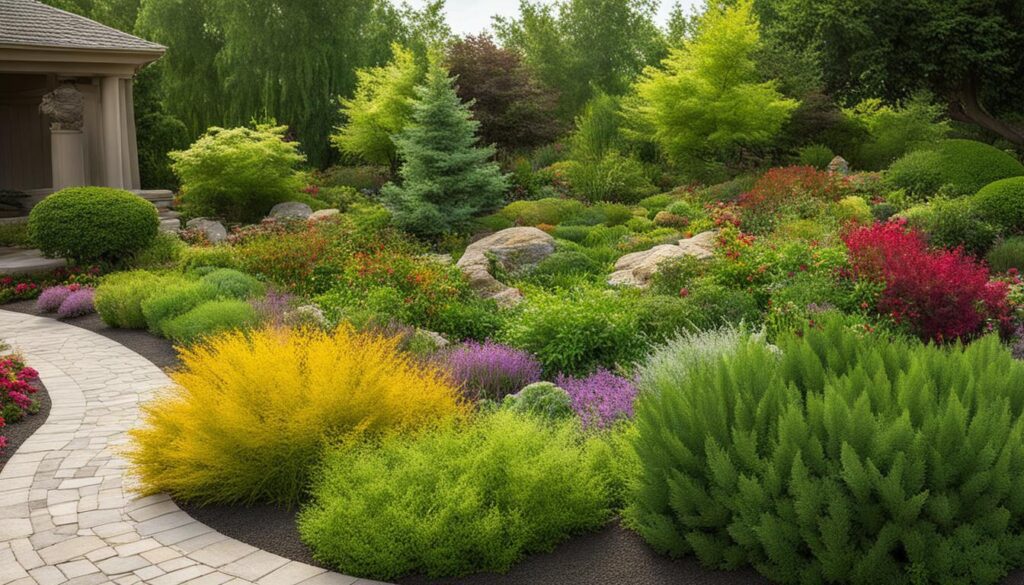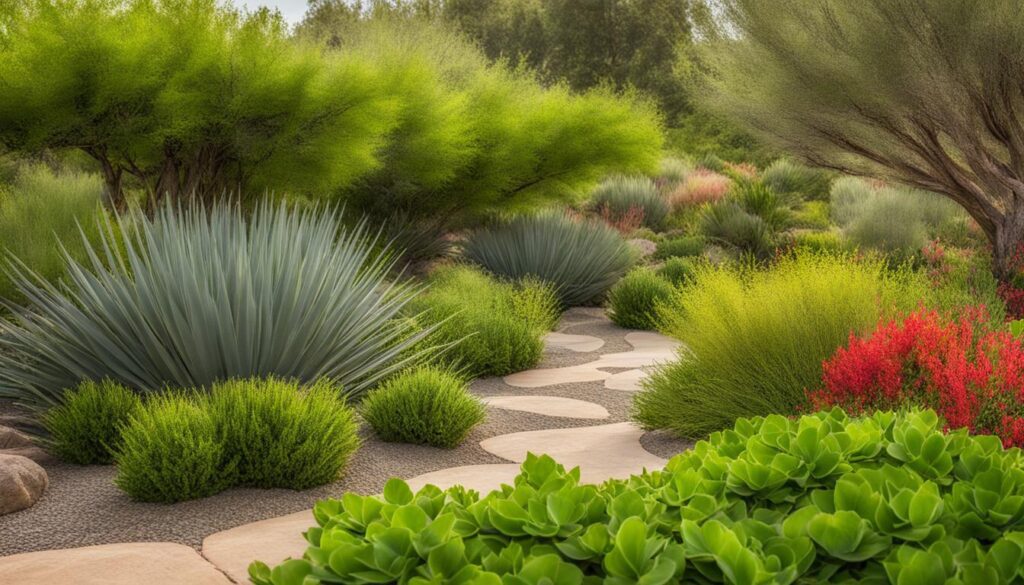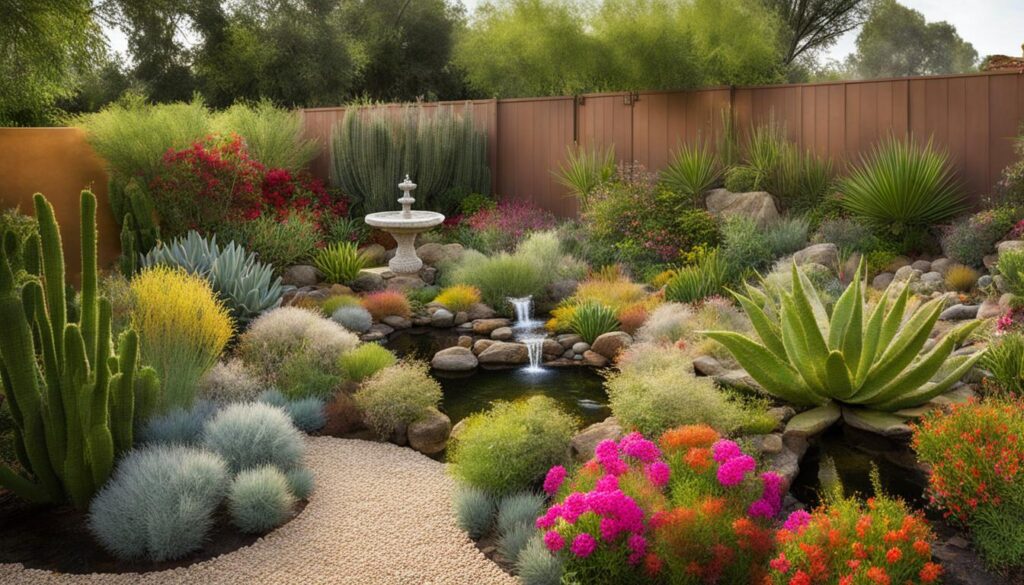Welcome to our guide on eco-friendly xeriscaping with native shrubs! If you’re looking to create a sustainable oasis in your garden while conserving water, saving time, and benefiting the planet, xeriscaping is the perfect solution for you. By using native shrubs that are adapted to your local climate, you can transform your outdoor space into a beautiful and low-maintenance landscape. Let’s explore what xeriscaping is, how it works, and the benefits it offers. Get ready to unlock the secrets of eco-friendly xeriscaping and embark on a journey towards a greener and more sustainable garden.
Key Takeaways:
- Eco-friendly xeriscaping with native shrubs can transform your garden into a sustainable oasis.
- Xeriscaping involves using native plants adapted to your local climate to conserve water.
- By implementing water-saving techniques and minimal maintenance, xeriscaping saves time and money.
- Choosing native shrubs for xeriscaping not only benefits the environment but also creates visually appealing landscapes.
- Xeriscaping is an ideal landscaping solution for areas with limited access to water and dry climates.
What is Xeriscaping and How Does it Work?
Xeriscaping, derived from the Greek word ‘xeros’ meaning dry, is a landscaping technique that focuses on creating beautiful outdoor spaces in dry climates. It involves using native plants that are adapted to the local climate and require less water. By strategically placing these plants, xeriscaping can create lush and colorful landscapes that are as appealing as traditional gardens.
The principles of xeriscaping include planning and design, suitable plant selection, soil improvement, efficient irrigation, the use of mulch, and proper maintenance. Xeriscaping is not just about water conservation, but also about creating sustainable and eco-friendly gardens that are in harmony with the local environment.
The Benefits of Xeriscaping with Native Shrubs
Xeriscaping with native shrubs offers numerous benefits. First and foremost, it helps conserve water by reducing the amount of water needed for irrigation. This can result in significant water savings, especially in areas with limited water resources. Xeriscaping also requires less maintenance compared to traditional landscaping, as native plants are adapted to the local conditions and require less watering, fertilizing, and pruning.
Moreover, xeriscaping can be cost-effective in the long run, as it reduces water bills and the need for expensive lawn tools. By incorporating native shrubs into your xeriscaped garden, you can create a beautiful and sustainable outdoor space that is both environmentally friendly and visually appealing.
Xeriscaping Tips for a Water-Friendly Garden
- Select and group plants with similar light, water, and soil requirements to ensure they thrive in your xeriscaped garden.
- Improve the soil by adding compost or garden soil to enhance water retention and provide essential nutrients for plant growth.
- Use mulch to suppress weeds, retain soil moisture, and regulate soil temperature.
- Adopt efficient watering techniques such as drip irrigation or soaker hoses to minimize water waste.
- Water plants infrequently but deeply to promote deep root systems that can withstand hot and dry conditions.
By following these xeriscaping tips, you can create a thriving and sustainable garden that minimizes water usage and maximizes the beauty of native shrubs.
The Benefits of Xeriscaping With Native Shrubs
Xeriscaping with native shrubs offers numerous benefits for both you and the environment. By incorporating native shrubs into your xeriscaped garden, you can create a beautiful and sustainable outdoor space that is both visually appealing and eco-friendly.
Water conservation: One of the primary benefits of xeriscaping with native shrubs is its ability to conserve water. Native plants are adapted to the local climate and require less watering compared to non-native species. This results in significant water savings, especially in areas with limited water resources.
“Using native shrubs in xeriscaping can reduce water usage and preserve water resources, making it an environmentally responsible choice.”
Low maintenance: Another advantage of xeriscaping with native shrubs is its low maintenance requirements. Native plants are well-suited to the local conditions, meaning they are more resilient and require less watering, fertilizing, and pruning. This saves both time and effort, allowing you to enjoy your garden without the hassle of constant upkeep.
Cost-effective landscaping: Xeriscaping with native shrubs can also be cost-effective in the long run. By reducing water usage, xeriscaping helps lower water bills and minimize the need for expensive lawn tools. Additionally, the low maintenance requirements of native shrubs mean fewer expenses on fertilizers, pesticides, and other gardening supplies.
Overall, xeriscaping with native shrubs is a sustainable and practical landscaping choice that offers benefits such as water conservation, low maintenance, and cost-effectiveness. By embracing this eco-friendly approach, you can create a beautiful outdoor space that not only enhances your property but also contributes to a greener and more sustainable future.
Xeriscaping Tips for a Water-Friendly Garden
Creating a water-friendly garden through xeriscaping involves implementing a range of strategies that conserve water and promote the growth of drought-resistant plants. Here are some tips to help you create a thriving and sustainable garden:
1. Select Drought-Resistant Plants: Choose native shrubs and plants that are adapted to your local climate. These plants require less water and are more resilient during dry spells.
2. Improve the Soil: Enhance the water-retention capacity of your soil by adding compost or garden soil. This helps the soil retain moisture for longer periods and reduces the need for frequent watering.
“By carefully choosing plants that are adapted to the local climate and implementing water conservation techniques, xeriscaping can create beautiful landscapes while minimizing water usage.”
3. Mulch, Mulch, Mulch: Apply a layer of mulch around your plants to help retain moisture in the soil and suppress weed growth. Mulch also acts as an insulator, protecting plant roots from extreme temperature fluctuations.
4. Efficient Watering Techniques: Adopt water-efficient irrigation methods such as drip irrigation or soaker hoses. These systems deliver water directly to the plant roots, minimizing evaporation and ensuring efficient water usage.
Additional Tips:
- Group plants with similar water and light requirements together to maximize efficiency.
- Water plants infrequently but deeply to promote deep root growth.
- Consider using rainwater harvesting systems to collect and reuse rainwater in your garden.
- Regularly monitor and adjust your irrigation schedule based on weather conditions and plant needs.
By following these xeriscaping tips, you can create a beautiful and water-friendly garden that not only conserves water but also enhances the overall sustainability of your outdoor space.
Conclusion
Xeriscaping with native shrubs is an eco-friendly and sustainable solution for landscaping in dry climates. By incorporating native plants that are adapted to the local environment, you can create a beautiful and water-conserving garden. Xeriscaping not only saves water but also reduces environmental impact and promotes sustainable gardening practices.
The use of native plants in xeriscaping contributes to the preservation of local biodiversity and enhances the natural beauty of your garden. These plants have evolved to thrive in the specific climate conditions, requiring less water and maintenance compared to non-native species. By choosing native plants, you can create a garden that is in harmony with its surroundings.
Water conservation is a key focus of xeriscaping, as it involves strategic planning and design to minimize water usage. Efficient irrigation techniques such as drip irrigation and soaker hoses ensure that water is delivered directly to the plants’ roots, reducing evaporation and runoff. Additionally, adding mulch to your xeriscaped garden helps retain moisture in the soil, reducing the need for frequent watering.
Embracing xeriscaping with native shrubs not only benefits the environment but also offers long-term cost savings. With reduced water consumption, you can lower your water bills and minimize the need for expensive lawn care equipment. By creating a sustainable oasis in your garden, you contribute to a greener future while enjoying the beauty of native plants.












